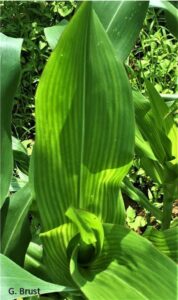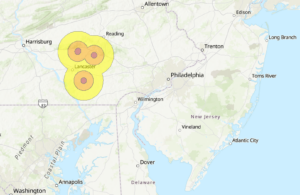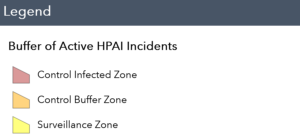Vegetable Crops Edition
Seasonal updates and alerts on insects, diseases, and weeds impacting vegetable crops. New Jersey Commercial Vegetable Production Recommendations updates between annual publication issues are included.
Subscriptions are available via EMAIL and RSS.
Quick Links:
 NJ Commercial Vegetable Production Recommendations
NJ Commercial Vegetable Production Recommendations
 Rutgers Weather Forecasting - Meteorological Information important to commercial agriculture.
Rutgers Weather Forecasting - Meteorological Information important to commercial agriculture.
Resources for Attendees of 2023 Central Jersey Vegetable Growers Meeting
Last Two Food Safety Trainings Until Fall
March 1, 2023: Advanced Audits Online Training from 9:00-12:00
This online program offers growers a deeper dive into audit standards and on-farm food safety issues they face on their farms. Current hot topics in food safety will be discussed as well as how to foster a food safety culture on your farm, updates to the harmonized audit, post-harvest sanitizer use and labeling and more! Certificates will be sent out to those who participate in this program.
$15.00 per person
Deadline to Register is February 27, 2023
March 15, 2023: Food Safety Training for Blueberry Growers from 10:00-1:00
Topics included horticulture sanitizer chemistry and how they work, a risk vs. hazard hands-on training, updates to the FSMA Ag Water Rule, an update on Traceability, what the New Jersey Department of agriculture found in 2022 during FSMA inspections and more. Certificates will be sent out to those who participate in this program.
Where:
Philip E. Marucci Center for Blueberry and Cranberry Research
125a Lake Oswego, Chatsworth, NJ 08019
$50.00 per person (lunch included)
Deadline to Register is March 8, 2023
For more information or to sign up for both trainings: Go to: https://go.rutgers.edu/8bgart4a
December Prices Received by Farmers Data
The ‘December Prices Received by Farmers’ section of the USDA NASS Agriculture Prices publication contains useful price-margins-costs of production forecasting information for producers.
The report highlights prices received by farmers for principal crops, livestock and livestock products; indexes of prices received by farmers; feed price ratios; indexes of prices paid by farmers; and parity prices. Historical data covering years 1910-60 reported in 1962 publication.
To access the December report go to: https://downloads.usda.library.cornell.edu/usda-esmis/files/c821gj76b/gx41nx339/2b88rs02s/agpr0123.txt
Future reports will be released on: Upcoming releases:Feb 28 2023 3:00 PM. Mar 31 2023 3:00 PM. Apr 28 2023 3:00 PM. May 31 2023 3:00 PM. Jun 30 2023 3:00 PM. Jul 28 2023 3:00 PM. Aug 31 2023 3:00 PM. Sep 29 2023 3:00 PM. Oct 31 2023 3:00 PM. Nov 30 2023 3:00 PM. Dec 29 2023 3:00 PM.
‘Fields of Devotion’ screening in New Brunswick, 2-4pm on March 3rd

Please click here to RSVP today.
- Fields of Devotion film screening
- A discussion with the film’s featured farmers and scientists
- Networking reception for farmers, scientists, and students
Rutgers Soil Testing Laboratory adds Sulfur to Soil Fertility Analysis
Plant-available sulfur (sulfate) values have been added to Rutgers Soil Testing Laboratory fertility reports in the micronutrient reporting line. There are four interpretive categories: Low, Medium-low, Sufficient, and High. An explanatory paragraph follows near the end of the report to help interpret the reported value.

Symptoms of sulfur deficiency include yellowing or light green coloring on youngest tissue, thin stems and petioles, slow growth, and delayed maturity. Photo Credit: G. Brust, University of Maryland.
As the interpretative statements within the reports explain, sulfur analysis/interpretation is very complicated (similar to nitrogen) due to the many factors influencing it. Also, there is not full consensus among soil fertility experts on a best extraction method and critical values. Still, the sulfur value on the revised reports will provide an extra degree of information for understanding the soil & plant health. As with all micronutrient interpretations on the reports, the relevant RCE publication is referenced for further information; in the case of sulfur, RCE bulletin E365.
Help PA stop Hipath Avian Influenza spread. Sanitize vehicle tires, boots.
With increasing numbers of positive flock detections in Lancaster County, PA, and circulation of the virus in wild birds, please remember to wash farm truck vehicle tires and implement footwear-vehicle-pedal sanitation steps when driving to/from the feed mills, seed stores, and farm machinery dealers located in this region of Pennsylvania. Map current as of 2-22-2023.


The following link will take you to the control zone maps for current detections in Pennsylvania.
https://padeptag.maps.arcgis.com/apps/webappviewer/index.html?id=a9066a3d68a443a08043766cb84bf4ae
Additional information on protecting your backyard flock from exposure to Hipath avian influenza can be found in prior Plant Pest Advisory posts, and at the USDA website, ‘Defend the Flock’. https://www.aphis.usda.gov/aphis/ourfocus/animalhealth/animal-disease-information/avian/defend-the-flock-program/defend-the-flock-program
